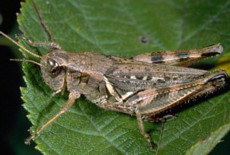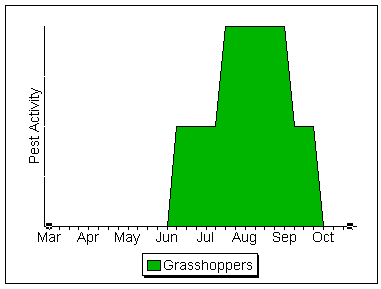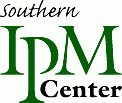Grasshoppers in Soybeans
Grasshoppers
Description
Several species of grasshoppers are present in Kentucky soybean fields and feed on soybean foliage. All have

Short-horned grasshopper
University of Kentucky Dept. Entomology
enlarged "jumping" legs. Mature hoppers will have wings. Some species never grow larger than 1/4 to 3/4 inch. It is these small species that usually cause the most damage.
Damage
Grasshoppers are mainly foliage feeders. Feeding will appear as very ragged holes beginning first on leaf margins. Under severe cases, petioles and stem will be eaten. Grasshoppers may also feed on soybean pods, especially during dry years. Drought conditions that reduce natural vegetation will force grasshoppers to move into cultivated fields.
IPM Techniques and Scouting
- In no-till fields it is important to scout for grasshoppers from cotyledon stage to first trifoliate. Under no-till conditions grasshoppers may occur very early in the season and be distributed across the field. For conventional tilled fields grasshoppers usually are not a problem until mid-summer but will be present all season. Grasshoppers tend to be more of a problem during dry weather.
- Grasshopper populations are very hard to estimate. When counting grasshoppers in a field do not walk in a straight line.
- Change the direction of your walk as you count so that the grasshoppers do not continually jump in front of you causing an overestimation of the population.
- Watch for large numbers of hoppers as you move through the field and watch for defoliation. The number of sites you need to examine in a field is based on the size of the field.
- Field borders should also be checked since grasshoppers tend to move into soybeans fields from the edges and spread across the field.
- Naturally occurring fungal diseases can drastically reduce grasshopper numbers. Dead and or dying grasshoppers may be found clinging to foliage.
Grasshopper Activity

Please note: These dates are approximations only. This calendar was constructed using data from Kentucky, USA. These dates may not apply in your area. You may wish to contact your county extension agent or agricultural consultant for information tailored to your locality.
References and Additional Information
- EntFact-116 - Three Common KY Grasshoppers and Their Natural Enemies
- IPM-3 Kentucky IPM Manual for Soybeans
- ENT-13 Insecticide Recommendations for Soybeans 1998, University of Kentucky Entomology Extension Publication ENT-13, Lexington, KY, 1998
- Illinois Field Crop Scouting Manual
- Purdue University - Field Crops Pest Management Manual
- Handbook of Soybean Insect Pests by Leon G. Higley and David J. Boethel, Entomological Society of America


